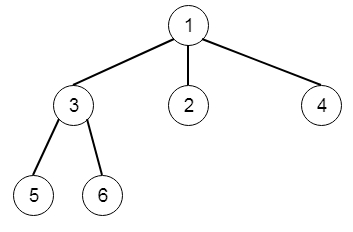
 Data Structure
Data Structure Networking
Networking RDBMS
RDBMS Operating System
Operating System Java
Java MS Excel
MS Excel iOS
iOS HTML
HTML CSS
CSS Android
Android Python
Python C Programming
C Programming C++
C++ C#
C# MongoDB
MongoDB MySQL
MySQL Javascript
Javascript PHP
PHP
- Selected Reading
- UPSC IAS Exams Notes
- Developer's Best Practices
- Questions and Answers
- Effective Resume Writing
- HR Interview Questions
- Computer Glossary
- Who is Who
N-ary Tree Level Order Traversal in C++
Suppose we have an n-ary tree, we have to return the level order traversal of its nodes' values. The Nary-Tree input serialization is represented in their level order traversal. Here each group of children is separated by the null value (See examples). So the following tree can be represented as [1,null,3,2,4,null,5,6]

The output will be [[1],[3,2,4],[5,6]]
To solve this, we will follow these steps −
make one matrix ans
if root is null, return ans
make one queue q and insert root
-
while q is not empty
size := size of the queue
make one array temp
-
while size is not 0
curr := first element of q
insert value of curr into temp
delete element from queue
-
for i in range 0 to size of the children of curr
insert ith children of curr
decrease size by 1
insert temp into ans
return ans
Let us see the following implementation to get better understanding −
Example
#include <bits/stdc++.h> using namespace std; void print_vector(vector<vector<auto> > v){ cout << "["; for(int i = 0; i<v.size(); i++){ cout << "["; for(int j = 0; j <v[i].size(); j++){ cout << v[i][j] << ", "; } cout << "],"; } cout << "]"<<endl; } class Node { public: int val; vector<Node*> children; Node() {} Node(int _val) { val = _val; } Node(int _val, vector<Node*> _children) { val = _val; children = _children; } }; class Solution { public: vector<vector<int>> levelOrder(Node* root) { vector < vector <int> > ans; if(!root)return ans; queue <Node*> q; q.push(root); while(!q.empty()){ int sz = q.size(); vector<int> temp; while(sz--){ Node* curr = q.front(); temp.push_back(curr->val); q.pop(); for(int i = 0; i < curr->children.size(); i++){ q.push(curr->children[i]); } } ans.push_back(temp); } return ans; } }; main(){ Node *root = new Node(1); Node *left_ch = new Node(3), *mid_ch = new Node(2), *right_ch = new Node(4); left_ch->children.push_back(new Node(5)); left_ch->children.push_back(new Node(6)); root->children.push_back(left_ch); root->children.push_back(mid_ch); root->children.push_back(right_ch); Solution ob; print_vector(ob.levelOrder(root)); } Input
[1,null,3,2,4,null,5,6]
Output
[[1, ],[3, 2, 4, ],[5, 6, ],]

